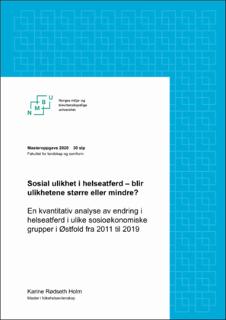| dc.contributor.advisor | Ihlebæk, Camilla | |
| dc.contributor.author | Holm, Karine Rødseth | |
| dc.coverage.spatial | Norway | en_US |
| dc.date.accessioned | 2021-02-08T13:53:26Z | |
| dc.date.available | 2021-02-08T13:53:26Z | |
| dc.date.issued | 2020 | |
| dc.identifier.uri | https://hdl.handle.net/11250/2726647 | |
| dc.description.abstract | Bakgrunn: Til tross for at Norge anses som et egalitært samfunn, finner man store sosiale ulikheter i helse, og ulikhetene er økende. En av forklaringene for hvorfor sosial ulikhet fører til ulikhet i helse er helseatferdsforklaringen, der sosiale forskjeller i livsstil fører til ulikheter i helse. Helseatferd kan øke risikoen for de såkalte ikke-smittsomme sykdommer, som innebærer hjerte- og karsykdom, kroniske lungesykdommer, diabetes, psykiske plager og muskel-skjelettplager. Det er derfor behov for mer kunnskap om utvikling over tid for helseatferd i ulike sosioøkonomiske grupper.
Formål: Undersøke eventuelle endringer i livsstil (røyking, snusing, alkoholbruk, inntak av frukt og fysisk aktivitet) fra 2011 til 2019 i et utvalg av befolkningen i Østfold, og videre undersøke om disse eventuelle endringene varierte med sosioøkonomisk posisjon målt ved grad av utdanning.
Metode: Repetert tverrsnittstudie. Datamaterialet ble hentet fra befolkningsundersøkelser utført av Østfold fylkeskommune i 2011 og 2019. For å undersøke om det var en endring i livsstilsvariablene fra 2011 til 2019 ble log-binominale regresjonsanalyser benyttet, og endring ble målt ved bruk av relativ risiko (RR). Materialet ble stratifisert på utdanning, kjønn og alder.
Resultater: For utvalget sett under ett ble det funnet nedgang i røyking og inntak av frukt, og økning i snusbruk, alkoholbruk og andel fysisk aktive. For alle livsstilsvariablene ble det funnet en sosial gradient, og forskjellene i forekomst av røyking, snusbruk og fruktinntak mellom høy og lav utdanning økte fra 2011 til 2019. Andelen som rapporterte inntak av alkohol to ganger i uken eller mer forble uendret for de med videregående og høyskole/universitets-utdanning, men økte for de med grunnskoleutdanning. Det var ingen endring for andel fysisk aktive for de med videregående og høyskole/universitet-utdanning, men i gruppen med grunnskoleutdanning var det en økning i andelen som var fysisk aktive.
Konklusjon: Det ble funnet sosiale forskjeller i helseatferd, og disse forskjellene økte fra 2011 til 2019 for røyking, snusbruk og fruktinntak. Den sosiale gradienten er særlig markant for røyking. Dette kan implisere at det er nødvendig med målrettede tiltak for å nå lavere sosioøkonomiske grupper i arbeidet mot sunnere levevaner. Enda viktigere kan det være å rette tiltak mot grunnleggende forskjeller i selve ulikhetsstrukturen. Økning i snusbruk og nedgang i frukt i kostholdet for befolkningen i Østfold er også uheldig utviklinger som bør få oppmerksom. | en_US |
| dc.description.abstract | Background: Despite Norway being considered as an egalitarian society, there are large social inequalities in health and those inequalities are increasing. One explanation for why social inequality leads to inequality in health is the health behavior explanation, where social differences in lifestyle lead to differences in health. Health behavior can increase the risk for non-communicable diseases. Hence, there is a need for a better understanding around the developments in health behavior over time across different socioeconomic groups.
Purpose: Study possible changes in lifestyle (smoking, snus and alcohol use, fruit intake and physical activity) from 2011 to 2019 in a sample of the population of Østfold county and further examine if these potential changes varied when taking into account different socioeconomic groups, which is measured by the level of education.
Method: Repeated cross-sectional study. The data analyzed stems from population surveys conducted by Østfold municipality in 2011 and 2019. To investigate if there had been any changes in the lifestyle variables from 2011 to 2019, log-binomial regression analyses were undertaken, and changes were measured using relative risk (RR). The data was stratified by gender, age and level of education.
Results: The analysis for the overall sample from 2011 to 2019 shows a decrease in smoking and in fruit intake and an increase in snus, alcohol use and physical activity. A social gradient was found for all lifestyle variables, and the differences in the incidence of smoking, snus use and fruit intake increased between higher and lower education. The proportion who reported alcohol consumption twice a week or more remained unchanged for those with upper secondary and college/university education and increased for those with primary school education. There was no change in the proportion of physically active people when it comes to those with upper secondary and college/university education, but for those with primary school education the proportion of physically active people increased.
Conclusion: Findings show social differences in health behavior, by level of education, and the differences increased from 2011 to 2019 in smoking, snus use and fruit intake. The social gradient is especially prominent when it comes to smoking. These findings may imply that targeted measures are needed to reach lower socioeconomic groups in the work towards healthier lifestyles. It might be even more important to target the fundamental differences within the structure of inequality. Decrease in fruit intake and increase in snus-use across the entire population are also unfortunate developments that requires action. | en_US |
| dc.language.iso | nob | en_US |
| dc.publisher | Norwegian University of Life Sciences, Ås | en_US |
| dc.rights | Attribution-NonCommercial-NoDerivatives 4.0 Internasjonal | * |
| dc.rights.uri | http://creativecommons.org/licenses/by-nc-nd/4.0/deed.no | * |
| dc.title | Sosial ulikhet i helseatferd - blir ulikhetene større eller mindre? : en kvantitativ analyse av endring i helseatferd i ulike sosioøkonomiske grupper i Østfold fra 2011 til 2019 | en_US |
| dc.title.alternative | Social inequality in health behavior – is the gap getting bigger or smaller? : a quantitative survey on health behavior changes in different socioeconomic groups in Østfold from 2011 to 2019 | en_US |
| dc.type | Master thesis | en_US |
| dc.description.localcode | M-FOL | en_US |

